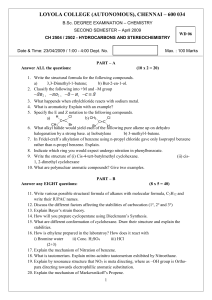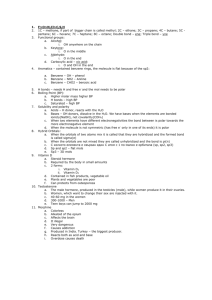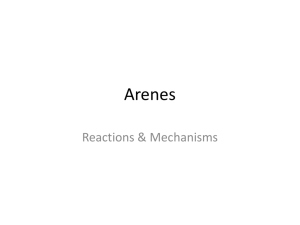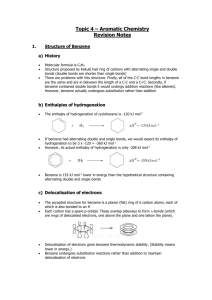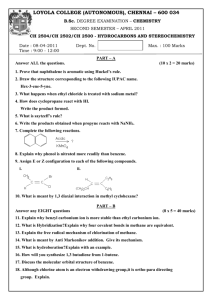The structure of benzene
advertisement
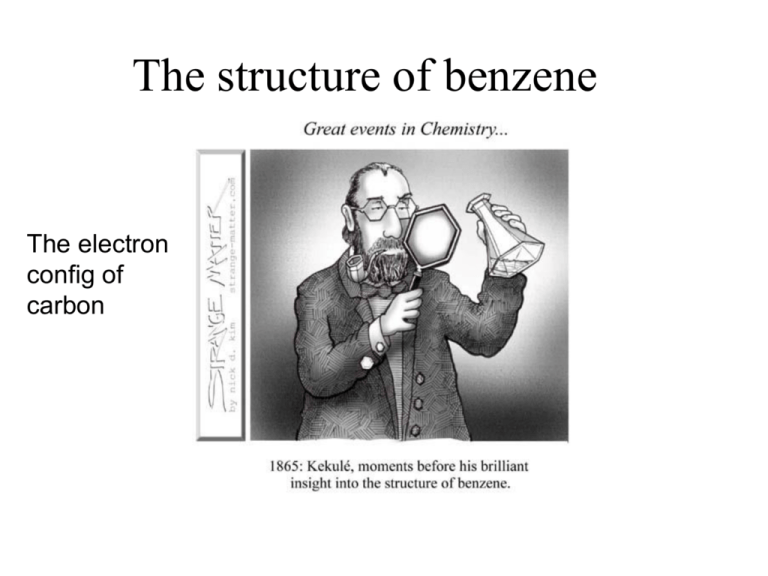
The structure of benzene The electron config of carbon This new hydrocarbon isolated by Michael Faraday in 1825 presented a huge problem. . The % of carbon was 92% Carbon (C= 12) . Its relative molecular mass was 78. Calculate the molecular formula The molecular formula is C6H6 suggesting that the molecule contained a large number of double bonds. Benzene did not, it was surprisingly unreactive All the chemistry they knew suggested that any substance with a double or triple bond would be very reactive and react readily with HBr in the dark. In 1865 after a dream about a snake biting its own tale, Kekulé suggested the following structure for benzene. This did not explain why the structure was so unreactive, the chemists of the time were convinced that it should react with bromine in the dark at room temperature. This does not happen with benzene. This does not fit with Kekulé’s idea of alternating double and single bonds. Another problem was the energy of hydrogenation (addition of hydrogen). The hydrogenation of cyclohexane is well known. So if three double bonds are present – as in benzene, then the comparable reaction should liberate 3 times that of cyclohexane. -(3 × 120) = - 360 kJ mol-1 But the actual value for benzene was found to be different. -208kJ mol-1 So benzene is (360-208) = 152 kJ mol-1 more stable than otherwise expected, or if it contained 3 ordinary C=C bonds. E -360kJ/mol (3 X –120) -208kJ/mol progress This is a better all round model than the Kekulé structure which shows 2 extremes of the same thing. The circle in the middle shows the delocalisation of the aromatic system. The bond length of C-C bonds in benzene are found someway between that of an alkane and an alkene. Bond Lengths /nm C-C cyclohexane 0.154 C=C cyclohexane 0.134 C-C in benzene 0.140 Evidence for delocalisation in benzene Hydrogenation energies are lower than expected Delocalised systems are highly saturated, but their reactions are of substitution rather than addition.. Carbon-Carbon bond lengths are equal in the delocalised system. Benzene is a flat molecule, with all atoms in the same plane,( bond angle 120) Any compound where the ratio of C:H is about 1:1 is likely to contain a benzene ring. When the benzene ring is attached to an aliphatic skeleton, it is called the phenyl group. The formula of a phenyl group id C6H5. There are several methods of displaying the formula of benzene, the standard A2 method is: . This represents the delocalised electrons, and is probably the best way of representing the delocalisation during mechanisms Exam points •Benzene is a flat molecule with 6 carbons bonded in a Planar ring •Each carbon is covalently joined to two other carbons and one hydrogen. A total of three covalent bonds •The remaining outer electron of each carbon is shared with the other carbons in the ring. The six electrons are delocalised around the ring system, giving stability •All bond lengths are the same. Never draw benzene as a simple hexagon. This would be a molecule of cyclohexane – this has no delocalised electrons, and is not flat like benzene. Also unless drawing mechanisms, never include the hydrogens attached directly to the benzene ring. This is bad chemistry. Naming benzene molecules 1.2-dimethyl benzene 1,4-dimethyl benzene 1,3dimethylbenzene 2-hydroxybenzoic acid benzene-1,4-dicarboxylic acid phenyamine chlorobenzene nitrobenzene Methyl 3-nitrobenzoate 2,4,6-trichlorophenol phenyl ethanoate phenylethanone phenol Benzoic acid phenylethene Fused ring systems


